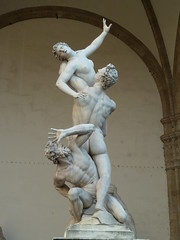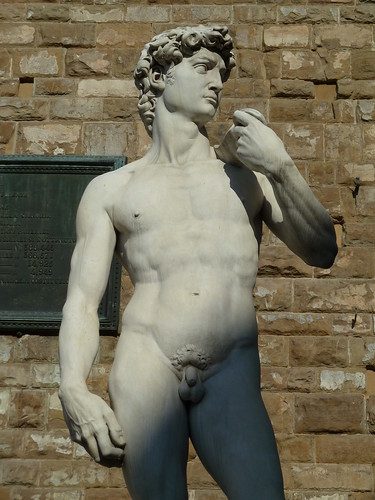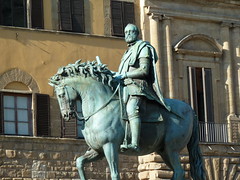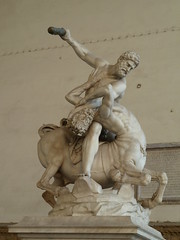 If the cathedral is the sacred center of Florence, then the Piazza della Signoria is the civic center of Florence. It's just a few minutes walk down the broad Via dei Calzaioli from the front of the cathedral to the Piazza della Signoria, where you first catch sight of the Palazzo Vecchio, the historic town hall and capital building from when Florence was a city-state. While the implied message of the cathedral's design is "be filled with awe and look up at heaven", the implied message of the Palazzo Vecchio is "we're a powerful city-state, so don't even think about messing with us". The Palazzo is a massive stone fortress with a sturdy tall bell tower and clock, dating from the early 1300s. While the design has definite beauty, it exudes strength and defensibility. The stone walls are obviously thick, with few windows on the lower floors and only one large door. The crenellation along the top looks graceful, but also provides the perfect combo of cover and opening for archers. Many of the upper arches contain small openings for dropping rocks or hot oil on unwelcome people outside the walls.
If the cathedral is the sacred center of Florence, then the Piazza della Signoria is the civic center of Florence. It's just a few minutes walk down the broad Via dei Calzaioli from the front of the cathedral to the Piazza della Signoria, where you first catch sight of the Palazzo Vecchio, the historic town hall and capital building from when Florence was a city-state. While the implied message of the cathedral's design is "be filled with awe and look up at heaven", the implied message of the Palazzo Vecchio is "we're a powerful city-state, so don't even think about messing with us". The Palazzo is a massive stone fortress with a sturdy tall bell tower and clock, dating from the early 1300s. While the design has definite beauty, it exudes strength and defensibility. The stone walls are obviously thick, with few windows on the lower floors and only one large door. The crenellation along the top looks graceful, but also provides the perfect combo of cover and opening for archers. Many of the upper arches contain small openings for dropping rocks or hot oil on unwelcome people outside the walls. The sense of history in this square is palpable. The great leaders of Florence, like the Medicis, held court in that palazzo, made great decisions, kept prisoners. It was in this piazza that Savanarola (a 15th century religious zealot a la Jerry Falwell who became a political leader for a time) conducted his infamous "bonfire of the vanities", where books and works of art deemed irreligious were burned in a great pyre in the square. When the city soon grew tired of his extremism, Savanarola was himself ultimately burned here too. (An inscription on a flat circular stone amidst the other cobblestones of the piazza marks the spot.)
The sense of history in this square is palpable. The great leaders of Florence, like the Medicis, held court in that palazzo, made great decisions, kept prisoners. It was in this piazza that Savanarola (a 15th century religious zealot a la Jerry Falwell who became a political leader for a time) conducted his infamous "bonfire of the vanities", where books and works of art deemed irreligious were burned in a great pyre in the square. When the city soon grew tired of his extremism, Savanarola was himself ultimately burned here too. (An inscription on a flat circular stone amidst the other cobblestones of the piazza marks the spot.)Upon approaching the palazzo, even from a distance one can't help but notice the two monumental statues that flank the large entrance. One is Michelangelo's David, and the other is a statue of Hercules vanquishing Cacus (a fire-breathing cattle thief). Both statues are solid marble, mounted on pedestals, and about 16-17 feet tall (not counting the pedestal), a rather imposing three times life size. David, looking like he eats nothing but steamed veggies and brown rice, naked and armed only with his sling, represents spiritual strength. Unlike the typical composition of David with his foot on top of Goliath's head, Michelangelo chose to sculpt him in the moment before the famous battle, looking pensively but determinedly toward his foe. In his placement here, his gaze is south toward Rome. Hercules, on the other hand, looking like he eats nothing bt raw meat and steroids, represents physical strength. He too is naked but armed with a club, and appears to be pausing, perhaps deciding whether he's sufficiently subdued his foe or not. He may also be reflecting the confusion of the time, as in the time this was sculpted (1525-34), there was much political turmoil in Florence, and the Medicis were in power, then out, then in again, and the commission of the sculpture was redirected a couple times. So whether Hercules represents Florence vanquishing her rival city-states or merely the Medicis vanquishing their political rivals is a matter of who's telling the story. In any case, anyone approaching the palazzo should be quite impressed by the stone guards at the door.
 As if that weren't enough, the square boasts a number of other rather muscular sculptures. At the corner of the palazzo, Neptune presides over a fountain, looking like he and Hercules would make a good cage match. Further in that direction is a regal bronze equestrian statue of Cosimo I Medici. On the opposite side of the square is the Loggia dei Lanzi, an outdoor sculpture gallery with various Roman and Renaissance works. As if more were needed to put the fear of Florence into approaching strangers, the collection includes Cellini's "Perseus with the Head of Medusa", an impressive bronze of Perseus, sword in right hand with Medusa's severed head held aloft in his left, and Medusa's fallen bare-breasted body at his feet, with guts gushing out of her open neck. Giambologna has a couple of great works here. Hercules, not pausing this time, but in stop-frame action actively clubbing a centaur. The sculpture is so active it is literally taut with tension, looking like it might unfreeze at any moment. And the Rape of the Sabine women, a fascinating work said to be the first multi-figure statue in European history with no single dominant viewpoint. The dynamic composition, of one man lifting up a woman while a fallen man cowers below him, has a twisting movement that impels you walk around the statue and view it from all sides. While the David is a replica (the original was moved indoors for restoration and preservation from the rain, soot, and bird poop), most of these other statues are the originals, and you can just walk among them, as it was in the 1500s when so many great artists flourished here.
As if that weren't enough, the square boasts a number of other rather muscular sculptures. At the corner of the palazzo, Neptune presides over a fountain, looking like he and Hercules would make a good cage match. Further in that direction is a regal bronze equestrian statue of Cosimo I Medici. On the opposite side of the square is the Loggia dei Lanzi, an outdoor sculpture gallery with various Roman and Renaissance works. As if more were needed to put the fear of Florence into approaching strangers, the collection includes Cellini's "Perseus with the Head of Medusa", an impressive bronze of Perseus, sword in right hand with Medusa's severed head held aloft in his left, and Medusa's fallen bare-breasted body at his feet, with guts gushing out of her open neck. Giambologna has a couple of great works here. Hercules, not pausing this time, but in stop-frame action actively clubbing a centaur. The sculpture is so active it is literally taut with tension, looking like it might unfreeze at any moment. And the Rape of the Sabine women, a fascinating work said to be the first multi-figure statue in European history with no single dominant viewpoint. The dynamic composition, of one man lifting up a woman while a fallen man cowers below him, has a twisting movement that impels you walk around the statue and view it from all sides. While the David is a replica (the original was moved indoors for restoration and preservation from the rain, soot, and bird poop), most of these other statues are the originals, and you can just walk among them, as it was in the 1500s when so many great artists flourished here.(Check out highlights of our photos from Florence, or the complete set of first day pics on Flickr.)







1 comment:
Blessings ...
All lovely, i have one question though,
Did the artist deliberately create the penises of the male figures deliberately miniscule as to not seem obscene?
Perhaps my question may seem crass but seriously think about it, if one is sculpting the human form/body in all its magnificent glory why shy away from depicting the human body as it truly is? It’s beautiful, yet these male sculptures are endowed with the gentiles of an adolescent l boy as if to apologize for daring to sculpt it and then minimize it as not to offend the sensibilities of others.
Take care,
Rhapsody
http://www.shelfari.com/rhapsodyphoenix
http://twitter.com/rhapsodyphoenix
Post a Comment